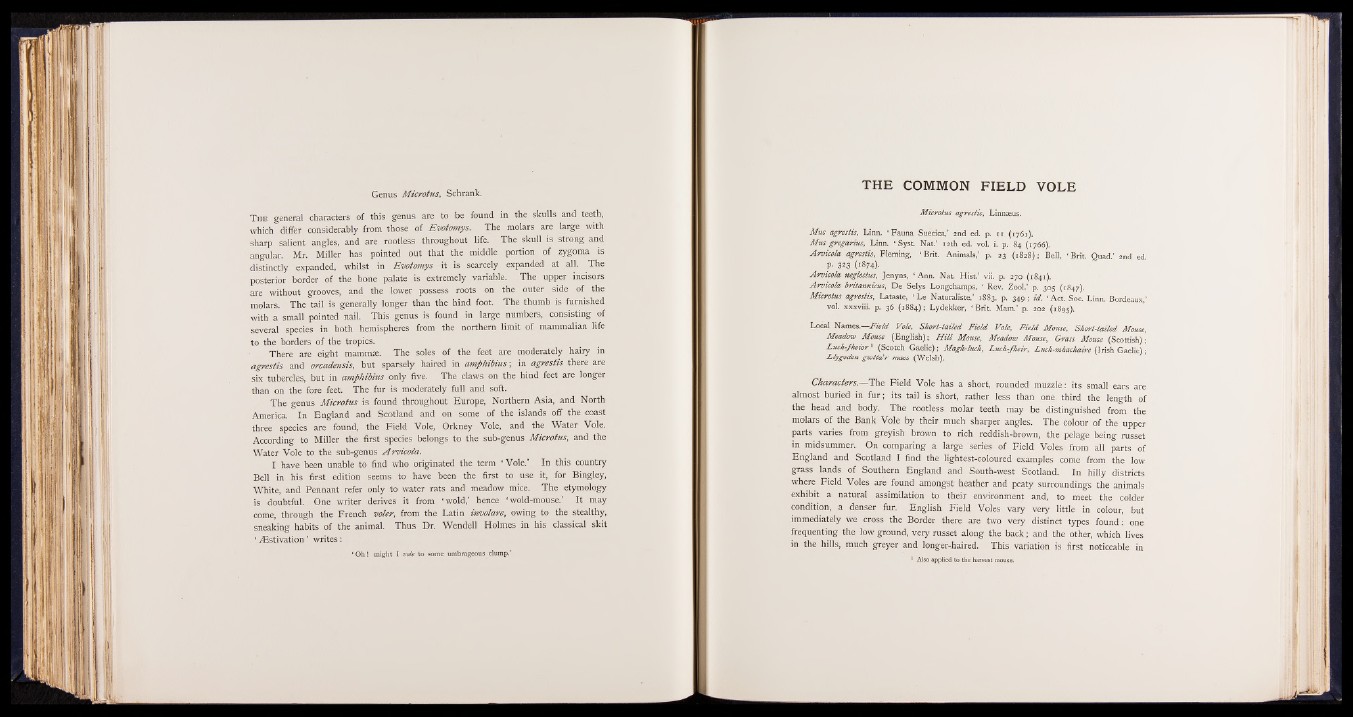
Genus Microtus, Schrank.
T h e general characters of this genus are to be found in the skulls and teeth,
which differ considerably from those of Evotomys. The molars are large with
sharp salient angles, and are rootless throughout life. The skull is strong and
angular. Mr. Miller has pointed out that the middle portion of zygoma is
distinctly expanded, whilst in Evotomys it is scarcely expanded at all. The
posterior border of the bone palate is extremely variable. The upper incisors
are without grooves, and the lower possess roots on the outer side of the
molars. The tail is generally longer than the hind foot. The thumb is furnished
with a small pointed nail.' This genus is found in large numbers, consisting of
several species in both hemispheres from the northern limit of mammalian life
to the borders of the tropics.
There are eight mammae. The soles of the feet are moderately hairy in
agrestis and orcadensis, but sparsely haired in amphibius; in agrestis there are
six tubercles, but in amphibius only five. The claws on the hind feet are longer
than on the fore feet. The fur is moderately full and soft.
The genus M icrotus is found throughout Europe, Northern Asia, and North
America. In England and Scotland and on some of the islands off the coast
three species are found, the Field Vole, Orkney Vole, and the Water Vole.
According to Miller the first species belongs to the sub-genus M icrotus, and the
Water Vole to the sub-genus A rvico la .
I have been unable to find who originated the term ‘ Vole.’ In this country
Bell in his first edition seems to have been the first to use it, for Bingley,
White, and Pennant refer only to water rats and meadow mice. The etymology
is doubtful. One writer derives it from ‘ wold,’ hence ‘ wold-mouse.’ It may
come, through the French voter, from the Latin involare, owing to the stealthy,
sneaking habits of the animal. Thus Dr. Wendell Holmes in his classical skit
‘ .Estivation ’ writes :
‘ O h! might I vole to some umbrageous clump.’
THE COMMON FIELD VOLE
Microtus agrestis, Linnseus.
Mus agrestis, Linn. ‘ Fauna Suecica,’ 2nd ed. p. n (1761).
Mus gregarius, Linn. ‘ Syst. Nat.’ 12th ed. vol. i. p. 84 (1766).
A rvicola agrestis, Fleming, ‘ Brit. Animals,’ p. 23 (1828); Bell, ‘ Brit. Quad.’ 2nd ed.
P- 323 (1874).
A rvicola neglectus, Jenyns, ‘ Ann. Nat. Hist.’ vii. p. 270 (1841).
A rvicola britannicus, De Selys Longchamps, ‘ Rev. Zool.’ p. 305 (1847).
Microtus agrestis, Lataste, ‘ Le Naturaliste,’ 1883, p. 349; id. ‘ Act. Soc. Linn. Bordeaux,’
vol. xxxviii. p. 36 (1884); Lydekker, ‘ Brit. Mam.’ p. 202 (1895).
Local Names.—F ie ld Vole, Short-tailed F ie ld Vole, F ie ld Mouse, Short-tailed Mouse,
Meadow Mouse (English); H ill Mouse, Meadow Mouse, Grass Mouse (Scottish)-
Luch-fheior1 (Scotch Gaelic); Magh-luch, Luch-fheir, Luch-mhachaire (Irish Gaelic)
Llygoden gw tta 'r maes (Welsh).
Characters.—The Field Vole has a short, rounded muzzle: its small ears are
almost buried in fu r ; its tail is short, rather less than one third the length of
the head and body. The rootless molar teeth may be distinguished from the
molars of the Bank Vole by their much sharper angles. The colour of the upper
parts varies from greyish brown to rich reddish-brown, the pelage being russet
in midsummer. On comparing a large series of Field Voles from all parts of
England and Scotland I find the lightest-coloured examples come from the low
grass lands of Southern England and South-west Scotland. In hilly districts
where Field Voles are found amongst heather and peaty surroundings the animals
exhibit a natural assimilation to their environment and, to meet the colder
condition, a denser fur. English Field Voles vary very little in colour, but
immediately we cross the Border there are two very distinct types found: one
frequenting the low ground, very russet along the back; and the other, which lives
in the hills, much greyer and longer-haired. This variation is first noticeable in
1 Also applied to the harvest mouse.